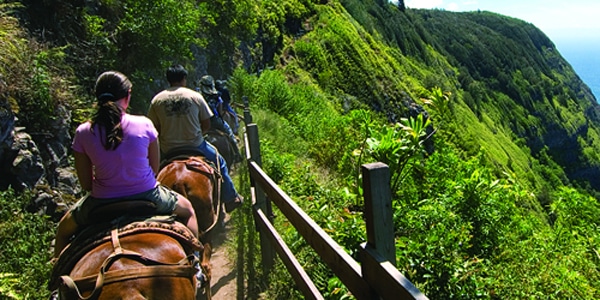Travel Tales: Man Vs. Mule
Footsteps. Through my heavy breathing, I hear them. KRUMP. KRUMP. My own footsteps have never sounded so loud, so urgent. A ragged uphill jog has so far taken me halfway up the Kalaupapa Trail, a two-mile trek of 26 switchbacks reaching from the Pacific Ocean to "Topside," the 1,700-foot-high plateau on the Hawaiian island of Molokai. My shirt is drenched in sweat, my hair soaked from a steady drizzle. I have to press on because I hear footsteps again, and this time they are not mine. It's the mules. They're gaining on me.
I'd made a bet. One born of my being stubborn and cheap. I could make it up to Topside on my own two feet, and I could do it faster than the mules. It seems everyone uses mules to reach the world's highest sea cliffs. You start in Kalaupapa, the isolated village at the base that served as an infamous leper colony for more than 100 years. Richard Marks didn't use mules. He hated being stuck in Kalaupapa, so as a youth in the 1950s, he'd try to escape up this same trail. After leprosy (or Hansen's disease) was shown to be curable, the banishment policy was lifted, and before his death in 2008 Richard founded Damien Tours to bring tourists to the trail.
There are 15 mule riders in today's group, and then there's me. I stretch. I hydrate. And then, after telling one more person what I'm doing, I charge to the trail. Forget that the mules are still being mounted in the corral. I am g-o-n-e.
I know I'll have to make good time in the first crucial minutes. Otherwise, I'll have to hike on dirt chewed up by the mules' hooves and also decorated with their fresh mounds. All on a path that narrows to 12 inches and sometimes teeters on a precipitous drop-off.
I start out whistling and exchanging a "good day" with an older Australian hiker. Feeling strong. Ten minutes later the heat has me gasping. A couple walking behind me stagger to a halt. My head is down, so I'm not sure what happened to the Aussie, but I figure he gave up a while back. I press on.
Then, 30 minutes into my climb, I'm ready to quit, especially when I see that I've only reached switchback 13, the halfway point. A horseshoe hangs from the marker, perhaps for good luck, but to me it feels like mockery. I can't tell how far back the mules are, but I know they're coming fast.
"They speed up on the way to the top and usually make it in an hour," said "Uncle Buzzy," the mule master of Molokai, when I talked to him earlier this morning. The 73-year-old stable owner has run mule trains for more than 30 years. He greeted me at daybreak with an iron grip of a handshake and spoke with shoeing nails in his teeth.
"The mules are sure-footed and smarter than horses." He looked up at me. "And smarter than a lot of people too."
Now, three-quarters of the way up the mountain, I drive myself like a farm animal, actually grabbing my legs to yank them over the concrete crossties supporting the trail. I'm 45 minutes in. Buzzy's warnings about the mules echo in my head: "They speed up. They make it in an hour."
I trudge through hundreds of old hoofprints, the soggy ruts almost sucking the sandals off my feet. For a moment I stop to scrape mud from my sandals, losing precious seconds. There's a faint clip-clopping behind me. I look for the mules, but the steep slope changes direction too often to see more than 100 feet. They could be anywhere, so I move onward.
I stop again to catch my breath and drain the last bit of water from my bottle. With hands on knees, I look up ahead and see a hint of blue sky above the next set of trees — the end of the trail. With one last shot of adrenaline, I pull myself toward the clearing. At 55 minutes I can feel the trail starting to flatten and then it winds, mercifully, through a shaded path and into the parking lot. This is Topside.
From here, half gloating and half recovering, I can see when the mules emerge from the trees. They're about 90 seconds behind me. A cab driver arrives to pick up a hiker who has yet to arrive. He looks at me and, impressed, says, "Under an hour, huh?" I nod, feigning humility. And then I see the older Australian guy, the one who started on the trail near me and then mysteriously disappeared. He's leaning against a tree, bored.
"Where you been, mate?" he asks, clearly fresh. "Taking snappies?"
"Nah," I say, and trying not to shame him, casually add, "Just made it up. Took about 58 minutes. You?"
He hands me some water. "I've been here for half an hour."
